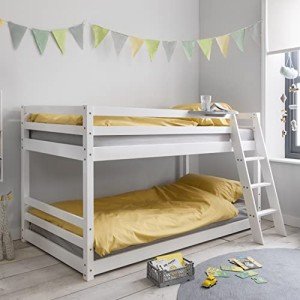Exploring Bunk Beds: A Comprehensive Guide
Bunk beds have long been a staple in children's bed rooms, dorms, and even homes with restricted space. Not only do they provide a useful sleeping solution, but they also develop a fun and imaginative environment for kids and a great space-saver for adults and households. This short article will check out whatever you require to learn about bunk beds, from types and materials to safety pointers and purchasing recommendations.
Table of Contents
- Kinds Of Bunk Beds
- Conventional Bunk Beds
- Loft Beds
- Triple Bunk Beds
- L-Shaped Bunk Beds
- Material Options
- Wood
- Metal
- Safety Considerations
- Purchasing Guide
- FAQs
Kinds Of Bunk Beds
Bunk beds can be found in various designs to match various requirements and preferences. Here's a breakdown of the most typical types:
Conventional Bunk Beds
Traditional bunks usually feature two beds stacked vertically on top of one another. These beds are ideal for siblings sharing a space or for maximizing sleeping space in visitor rooms.
Loft Beds
Loft beds stand similarly to traditional bunk beds however do not have a lower sleeping location. Instead, they typically integrate a desk or seating area underneath, making them a great option for small rooms needing multifunctionality.
Triple Bunk Beds
Triple bunk beds are created for 3 residents, with beds stacked in a three-tier setup. These are less common however can be a fun solution for large households or pajama parties.
L-Shaped Bunk Beds
With one bed positioned horizontally and the other vertically, L-shaped bunk beds are frequently equipped with additional features such as desks or storage drawers and can match corner spaces in a space.
Contrast of Bunk Bed Types
| Bed Type | Perfect Use | Description |
|---|---|---|
| Traditional | Shared bed rooms or guest spaces | Two beds stacked vertically |
| Loft | Little rooms requiring multi-purpose space | Upper bed with open space underneath |
| Triple | Big households or slumber parties | 3 beds stacked vertically |
| L-Shaped | Corner or flexible areas | A mix of vertical and horizontal beds |
Material Options
Bunk beds are manufactured from numerous products, with wood and metal being the most common. Each material has its pros and cons.
Wood
- Sturdiness: Generally robust and can withstand years of use.
- Aesthetic Appeal: Offers a timeless look that can blend with numerous decorations.
- Weight Capacity: Typically stronger; can support much heavier weights.
- Disadvantages: May be more pricey than metal choices and can be vulnerable to scratches.
Metal
- Toughness: Generally lightweight and easy to move however still strong.
- Modern Design: Often is available in sleek styles, making it appealing for contemporary spaces.
- Economical: Usually cheaper than wooden choices.
- Drawbacks: Can be cold to the touch in winters and might not have the same visual appeal for some buyers.
Safety Considerations
When it pertains to bunk beds, security can not be overlooked. Here are crucial safety suggestions to keep in mind:
- Guardrails: Ensure that the top bunk has guardrails on both sides to prevent falls.
- Durable Construction: Check for a solid construct and durable materials to hold up against weight and movement.
- Weight Limit: Adhere to the manufacturer's weight limit for both the upper and lower bunks.
- Ladder Design: Choose bunks with a safe, easy-to-climb ladder and avoid any sharp edges or rungs.
- Age Restrictions: Most makers recommend that children under the age of six should not oversleep the upper bunk.
Purchasing Guide
When looking for bunk beds, think about the list below aspects to find the very best suitable for your requirements:
- Space Availability: Measure the space size and ceiling height, making sure there is adequate space for the top bunk.
- Bed Size: Decide in between twin, full, or larger sizes based upon your requirements and the size of the space.
- Design Preference: Consider the overall decoration of the bedroom to find a suitable design.
- Reduce of Setup: Look for a bunk bed that is simple to put together.
- Budget plan: Bunk beds can be found in various cost ranges, so identify a budget before beginning your search.
Frequently asked questions
1. What is the suggested age for children to sleep on the leading bunk?
Children aged six and older are usually suggested to sleep on the top bunk to lessen the threat of falls.
2. How can I make my bunk bed much safer?
To improve security, ensure guardrails are effectively set up and examine that the bed is put on a flat surface area. In addition, motivate children to use the ladder thoroughly.
3. Can I convert a bunk bed into two different beds?
Lots of bunk beds are created to be convertible. Examine the manufacturer's specs for convertibility features.
4. What accessories are offered for bunk beds?
Common devices consist of bed linens, storage drawers, staircases rather of ladders, and tented canopies for an enjoyable visual appeal.
5. How do I preserve my bunk bed?
Routine look for loose screws or structural integrity can help ensure safety. Dust the bed frequently and tidy spills immediately to keep the products in good condition.
Bunk beds are flexible and a space-efficient solution for various living situations, from children's rooms to visitor lodgings. With Bunk Beds In Sale and products offered, potential purchasers have a wealth of choices to think about, guaranteeing a combination of usefulness and aesthetic appeals. By focusing on safety and following the suggestions outlined in this guide, individuals can discover the ideal bunk bed that fits their space and lifestyle, all while producing an enjoyable sleeping environment.

